This post may contain affiliate links and we may earn compensation when you click on the links at no additional cost to you.
There are plenty of resources to help you find your way from Point A to Point B along the Boston Freedom Trail, but this is a one-stop-shop for everything you need to know while on and around the Freedom Trail!
Officially, there are sixteen stops along the trail, so each of those stops will be numbered below, along with all the information you need about them.
The entire tour is 2.5 miles (4 kilometers), but after all the walking you do at each individual location, you’ll easily double this. It is best to start the Freedom Trail tour very early and well rested, because it will be a long day of exploring some of Boston’s and our Country’s most significant historic sites.
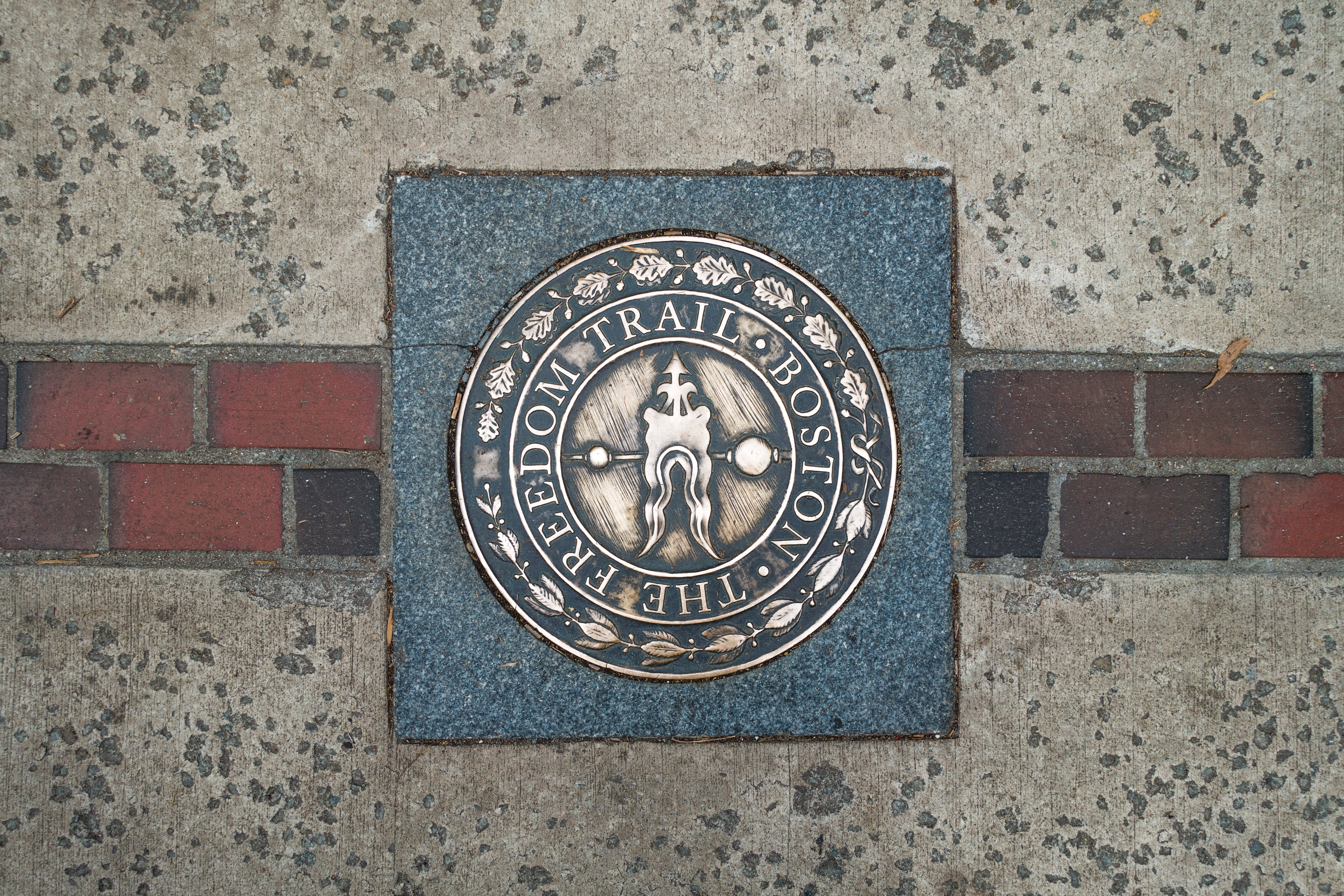
1. Boston Common
While you could start your tour at any stop along the Freedom Trail, this is the easiest place to start your tour. Boston Common is quickly accessible via public transportation and has a great vibe about it to get you ready for a day of exploring. It seems that Boston Common is bustling at any time of day, but on a weekend morning, among hundreds of other visitors, there were food trucks, live bands playing music, and tour guides dressed up in costumes to look like colonists.
Learn while you walk. Some facts about Boston Common:
- Established in 1634, making it the oldest public park in the United States.
- Boston Common was a place where local puritans could graze their livestock, but was also host to puritanical punishments. Most notably, there was at one time a hanging tree and a whipping post stationed in Boston Common.
- During British Occupation of Boston in 1775, Boston Common served as a campsite for over 1000 British Soldiers.
Bonus Destination: Mooyah
While we were in Boston Common, we stopped at Mooyah, a build your own burger joint across the street! Delicious burgers, with plenty of vegetarian options!, and best of all, it is not too far of a detour off the Freedom Trail
2. Massachusetts State House

Standing tall just at the edge of Boston Common, it is hard to miss the gold dome of the Massachusetts State House as you walk along the Freedom Trail. From the official starting point of the trail, the Massachusetts State House is a 0.2 mile (0.32 kilometer) walk. The building is closed on weekends and holidays, but can be accessed or toured Monday through Friday from 8:45am to 5:00pm. Self-guided tours are available, or a guided tour is given, free of charge, Monday through Friday between 10am and 3:30pm. Tours last approximately 30 – 45 minutes.
Learn while you walk. Some facts about the Massachusetts State House:
- The land that was bought to build the State House was owned by John Hancock. Construction began two years after his death, on July 4th, 1795.
- The Gold Dome hasn’t always been there. In fact, originally, it was covered in shingles, and then in 1802, it was copper coated. It wasn’t until 1874 that the Gold leaf was added to the dome.
- During World War II, the dome was painted grey to keep the city dark. The Gold didn’t return to the dome until 1997.
3. Park Street Church
Park Street Church is just 0.1 miles (0.16 kilometers) away from the Massachusetts State House. This is a functioning church, and they ask that you please be respectful of their space. The Church is open for tours June 18th through August 30th, on Tuesdays through Saturdays, between 9:30am and 3:00pm.
Learn while you walk. Some facts about the Park Street Church:
- The first service was held here in 1810.
- Gunpowder was stored in the crypt below the church during the War of 1812.
- The Song “My Country Tis of Thee” was sung publicly for the first time from the steps of this church in 1831.
4. Granary Burying Ground
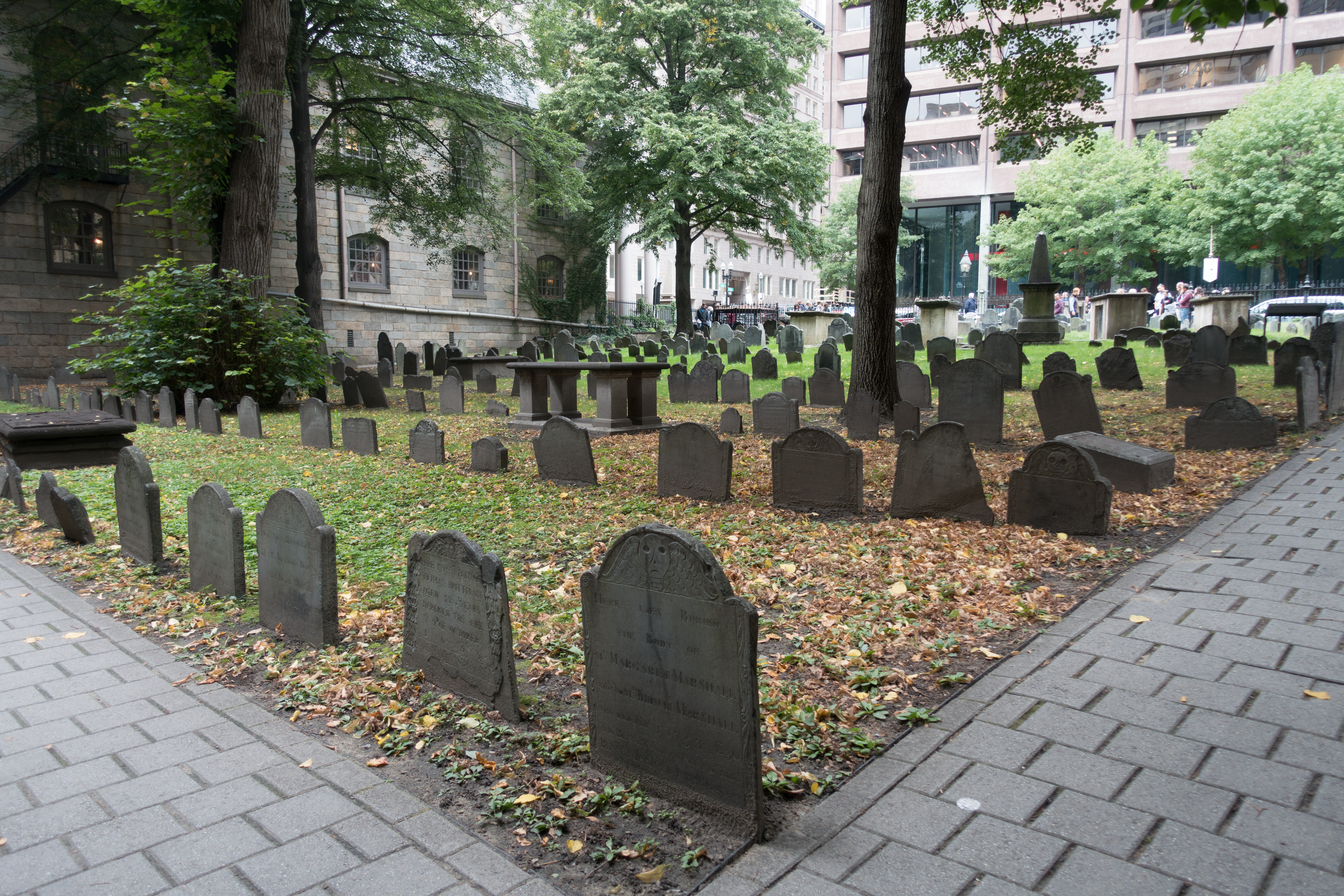
Right next door to the Park Street Church is the Granary Burying Ground, it’s a quick 0.08 mile walk away (0.13 kilometers). There should be someone standing up front, handing out guides to Granary Burying Ground. Grab one of those to help you make sense of the 2,300 markers that stand here.
Learn while you walk. Some facts about Granary Burying Ground:
- John Hancock, Samuel Adams, Robert Treat Paine, Paul Revere, and Ben Franklin’s parents are all buried here.
- It is estimated that there are between 5,000 – 8,000 people buried in this cemetery, although there are only about 2,300 headstones.
5. King’s Chapel & King’s Chapel Burying Ground
King’s Chapel is a 0.1 mile (0.16 kilometer) walk from Granary Burying Ground. It’s open year round for free tours: 10am – 4pm Monday through Saturday, and 1:30 – 4pm on Sundays in the Summer. It is only open Friday through Monday in the winter. We were not able to make the tours at King’s Chapel, but everyone says it’s highly recommended. While you’re walking through the King’s Chapel Burying Ground, you’ll notice a giant, caged in hole in the ground; that’s a subway vent!
Learn while you walk. Some facts about King’s Chapel & King’s Chapel Burying Ground:
- The original chapel on this ground was built in 1689, and housed the first Anglican congregation in the colonies.
- This current chapel started construction in 1749. Instead of tearing down the old chapel that stood in it’s place, they built the new chapel around the old one, and once construction was finished, they dismantled it brick-by-brick and passed it out the windows.
- The bell hung in the tower of the chapel was cast by Paul Revere.
6. Boston Latin School Site / Ben Franklin Statue
The next stop is the longest walk along the Freedom Trail so far; the Boston Latin School Site is a 0.3 mile (0.5 kilometers) walk away. One thing I love about the Freedom Trail is that everything is so close together so you can see all of these amazing destinations all at once. At the Ben Franklin Statue by the Boston Latin School, there are large trees canopying a sitting area. We grabbed a spot on a bench and took a minute to enjoy our surroundings.
Learn while you walk. Some facts about the Boston Latin School Site / Ben Franklin Statue:
- The Boston Latin School stood in the same spot that the Benjamin Franklin statue now stands. It was opened in April of 1635.
- This was the first public school in the United States (yaay!)
- Students included: Samuel Adams, Benjamin Franklin, John Hancock, and Robert Treat Paine.
- A law was passed in 1647 that required elementary schools be established in any municipality of 50 or more families.
7. Old Corner Bookstore
Perhaps the biggest disappointment along the Freedom Trail, I was very sad to see this historical site was turned into a Chipotle. After some research, I learned that the building was set to be torn down until a group launched preservation efforts and proposed it get turned into commercial space instead of flattened and turned into a parking garage. Even still, it is sad to see a place considered significant enough to be on the Freedom Trail now serving up build-your-own burritos. The Old Corner Bookstore is just 0.06 miles (0.09 kilometers) away from the Boston Latin School Site / Ben Franklin Statue.
Learn while you walk. Some facts about the Old Corner Bookstore:
- The most notable tenant of this building was publishing company Ticknor and Fields, who are best known for developing the royalties system for writers. Before their time, all book rights were purchased for a set fee.
- Harriet Beecher Stowe, Nathaniel Hawthorne, and Charles Dickens were all published by Ticknor and Fields.
Bonus Destination: Irish Famine Monument
Directly across the street from the Old Corner Bookstore, there is a monument to the Irish Famine. Its a little park that has plenty of spots to sit and reflect on the history that the monument is depicting.
8. Old South Meeting House
The Old South Meeting House is just across the street from the Old Corner Bookstore, a 0.04 mile walk (0.06 kilometers), if you were curious. This was the first stop we paid to tour along the Freedom Trail. The Old South Meeting House was the place where talks of revolution began. The Boston Tea Party was planned here. It seemed like an important place to go visit, and we have AAA, so we got a discount to go inside. What did we have to lose? Honestly, it wasn’t my favorite stop of the day.
Yes, it was an influential place, but there were so many things to read, and with our limited time span, I couldn’t fully enjoy and appreciate what we were reading, because I was too busy panicking that we wouldn’t have enough time for the other stops if we kept reading. But we stayed, read all the information they had to share, and learned a lot about the specific people who lived in Boston during the time of the Revolution, which gave a face to some names I had heard before. Recommended stop if you have a few days to spend exploring the Boston area, but if you’re trying to see it all in a day, I’d skip the museum tour.
Learn while you walk. Some facts about the Old South Meeting House:
- It was behind these very walls that the Boston Tea Party was launched.
- During the British Occupation in Boston, the pews were ripped out, the room filled with dirt, and the space was used as a riding school.
9. Old State House
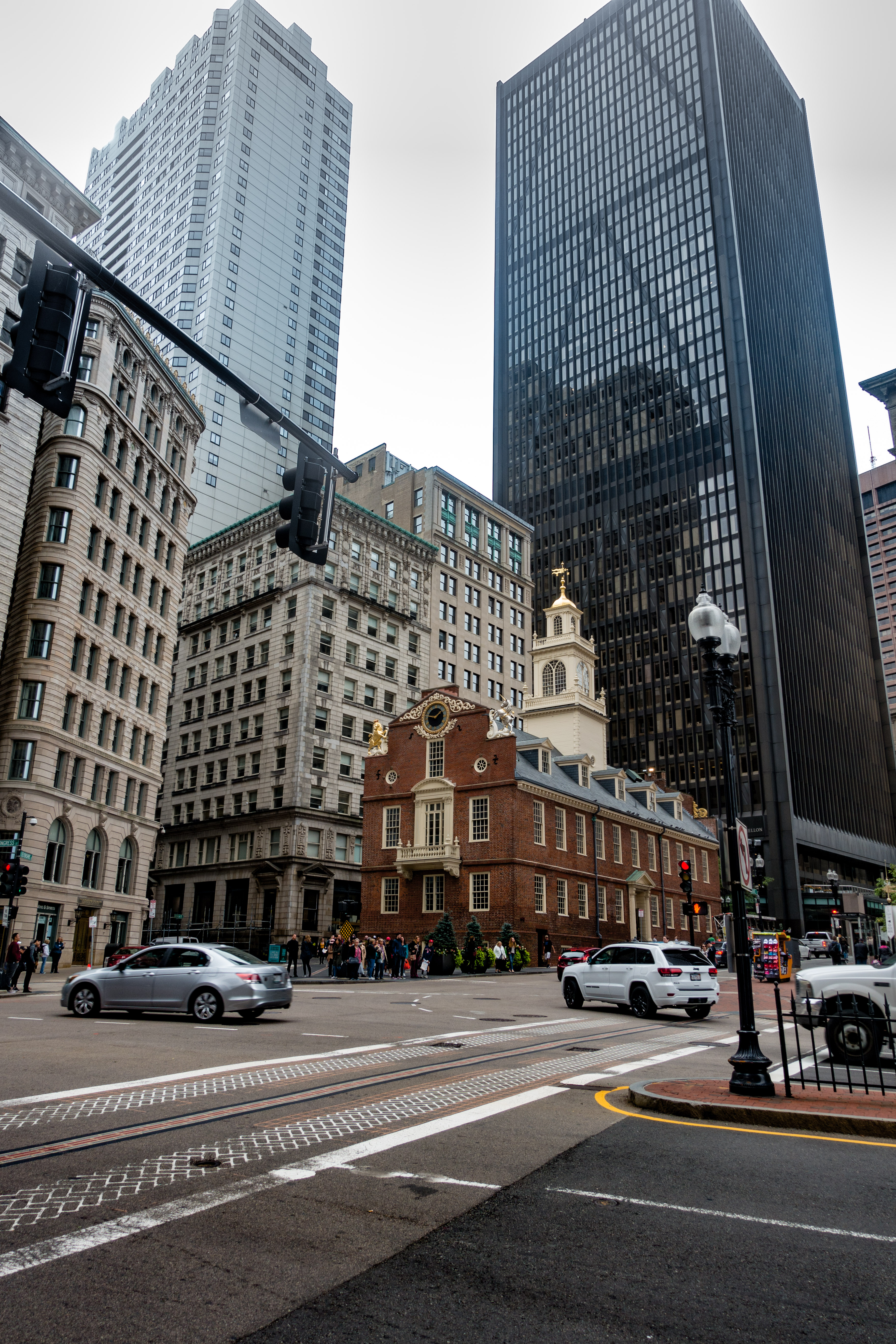
Unfortunately, we didn’t get the chance to check out the Old State House. It is another quick walk away from the Old South Meeting House, clocking in at 0.1 miles (0.16 kilometers) away. This building is currently owned by the Bostonian Society and is home of museum exhibits about the Boston Massacre and the history of the building itself. This is top of our list when we return to Boston. We love exploring a place with unique artifacts.
Learn while you walk. Some facts about the Old State House:
- This is the site of Boston’s first official town hall, dedicated in 1658. Unfortunately, this original building burnt down in the Great Fire of 1711. It was rebuilt by 1713, and destroyed in another fire in 1747. The current building was completed in 1750.
- This building served as British Government Offices during the British Occupation.
- On July 18th (MY BIRTHDAY!!) in 1776, the Declaration of Independence was read from the balcony on the back of the building for the very first time.
- In the 1870s, the city of Chicago offered to buy the building, after it had fallen into extreme disrepair, and relocate it to Lake Michigan. Embarrassed by this offer, the Bostonian Society was formed and the building was restored.
10. Boston Massacre Site
At the same stop along the trail as the Old State House, and just around back of the building, you’ll find a large circular marker for the Site of the Boston Massacre. Flooded with people taking photos, the meaning of this site is all but lost. Take a peak at a plaque that mentions the Boston Massacre which occurred near this spot on March 5th, 1770. Maybe snap a photo with a few people’s feet in it, and keep moving!
Learn while you walk. Some facts about the Boston Massacre Site:
- British soldiers killed five and wounded six angry Bostonians on this site.
- This was an important event in provoking Colonial unrest.
11. Faneuil Hall
Take a 0.2 mile, (0.32 kilometer) walk from the Boston Massacre Site, and you’ll find Faneuil Hall. One of the most notable things about this destination for me is that the National Parks Service has an information desk in here! They have tons of Passport stamps, maps, and knowledge to share. In addition, the inside of Faneuil Hall is filled with tons of shops. This might be a good place to grab a souvenir or a bite to eat. When we were here, there was even live music going on outside. Park Rangers lead talks here every 30 minutes or so. The building is open daily from 9am – 5pm.
Learn while you walk. Some facts about Faneuil Hall:
- Faneuil Hall was given to the City of Boston by Paul Faneuil. Paul Faneuil earned his fortunes as a trade merchant (he was involved in a trading operation that shipped slaves from Africa to the West Indies.) He also inherited a large sum of money from his Uncle, on the condition that he never married.
- Peter proposed building Faneuil Hall so that Boston had a central market where people could sell goods. While they were a major seaport in the early 1700s, they didn’t have a central market in town for sales.
- The construction was completed in September of 1743, only six months before the namesake’s death.
- In May of 1764, Faneuil Hall hosted the first protest against the Sugar Act.
- So many other historic events happened here, surrounding the Revolutionary War, the Civil Rights Movement, and the Women’s Rights Movement. Samuel Adams lead talks about the tea taxes here, and John F. Kennedy gave his final campaign speech here before he was elected President. Ask a Park Ranger for more information about what happened in this building!
12. Paul Revere House
To get from Faneuil Hall to the Paul Revere House, you’ve got a bit of a trek. The next stop is 0.4 miles (0.64 kilometers). After walking and standing all day, this is the point along the Freedom Trail where it starts to feel like you’ve been walking and standing all day.
This house really stands out because it is the only one on this city block that appears to bow slightly, and because it is made of a dark wood and fenced in by an admission booth amongst modern Boston buildings. We paid to get into this house too. The lines to get into each room were incredibly long, so if you have trouble standing for any long periods of time, this may not be the best stop for you.
I thought this place was really cool and am so glad we stuck it out to see what was inside. Each room of the house was filled with artifacts of the time that help to illustrate what Paul Revere’s life looked like. Each room was kept behind a gate, and at the gate were three or four signs that narrated what you were looking at. That’s where the lines came in. People were waiting to read the plaques, and eventually there was a bit of back up. The whole building creaked with every step, but this only added to the feeling that you were somewhere important.
Learn while you walk. Some facts about Paul Revere’s House:
- This is the oldest remaining building in Boston. It is estimated that the original house was built around 1680, but purchased by Paul Revere in 1770.
- The building was sold in 1800, and transformed into commercial space. It was purchased by Revere’s great grandson in 1902 to prevent its demolition.
- The building reopened in 1908 as one of the earliest historic home museums in the United States.
Bonus Destination: Mike’s Pastries
While we were walking around, it seemed that everyone was carrying around a box of pastries from a place called Mike’s Pastries. Intrigued, we eventually went back to check out what all the hype was about. Inside, there were huge lines, but at the end of the line, were some burrito-sized cannolis, cheesecakes, cookies, and every other sweet you could dream up. The over 20 flavors of cannolis seemed to be what they were known for, and they didn’t disappoint. If you’re curious about stopping, be sure to grab your box of Mike’s Pastries before you get too far away from this stop.

13. Old North Church
Continuing on the life of Paul Revere, this next stop, a 0.3 mile (0.48 kilometers) walk away, is the site of the infamous “One if by Land, Two if By Sea,” where Paul Revere started his midnight ride after seeing the signal “By Sea” from the top of the steeple. Unfortunately we didn’t time our day out with enough time to see this spot before it closed, but the church is open for tours and offers a behind the scenes tour where you can climb up into the bell tower where the lanterns were hung. Another spot on our list of places to see when we return.
Learn while you walk. Some facts about Old North Church:
- This is the oldest church remaining in Boston, completing construction in 1745.
- This was an Anglican Church (a church loyal to the British King) which meant it was very dangerous for Robert Newman to have hung the lanterns in the window signaling the British Invasion.
14. Copp’s Hill Burying Ground
Continuing down the road just 0.1 miles (0.16 kilometers), you’ll find a small plaque identifying the Freedom Trail (a good photo opp) before entering the Burying Ground.
Learn while you walk. Some facts about Copp’s Hill Burying Ground:
- The Oldest Gave marker is dated 1661.
- During the British invasion, the soldiers used the tomb stones as target practice, and the bullet marks can still be seen on these markers today.
Bonus Destination: the Smallest House in Boston
Directly across the street from Copp’s Hill Burying Ground is the smallest house in Boston. Just to emphasize how tiny the house is, a car parked directly in front proves that this tiny house is indeed skinnier than the width of an average car. The house is only 10.4 feet wide, and tapers off to be only 9.2 feet in the back of the building. Wish we could have gotten a peek inside!
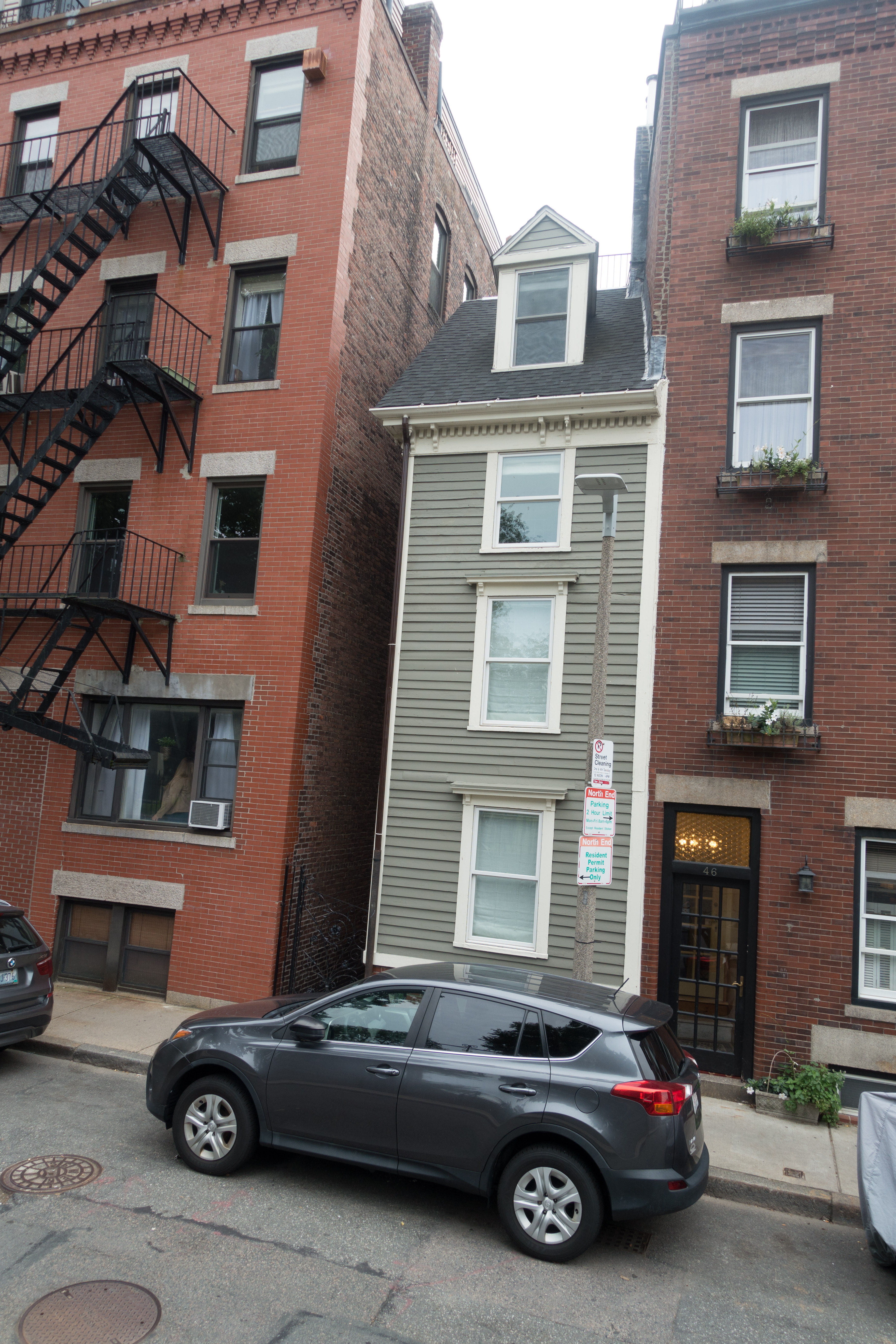
15. USS Constitution
I never thought this walk was going to end. After hours and hours of walking and standing and touring the city of Boston, this 0.9 mile (1.45 kilometer) walk from Copp’s Hill Burying Ground was just about the death of me. I whined the whole way there. I just wanted to stop walking. As soon as we got to the USS Constitution, all my pains and complaints fizzled away. There are a couple places you can go around this area in the Navy Yard, but I highly recommend checking out the USS Constitution, the official stop along the Freedom Trail.
The USS Constitution is run and maintained by the National Parks Service now, and tours of the boat are free. You do have to check in at a security desk with a photo ID and put your bags through an X-Ray. The lines for this moved very quickly (shockingly quick) and we were inside the gate in no time.
Once inside, the whole thing is a free-for-all. A large majority of the ship is open for exploration. There are plenty of ladders to climb, windows to peek in, and cannons to trip over (okay, maybe that last one is just me…) Really cool stop, lots of knowledgeable Park Rangers around to answer questions or explain things to a naval novice like me. If you’re tall, like Jason, be prepared to duck. if I had to guess, judging by my own height, the clearance height for the lower decks is only about 5’4″.
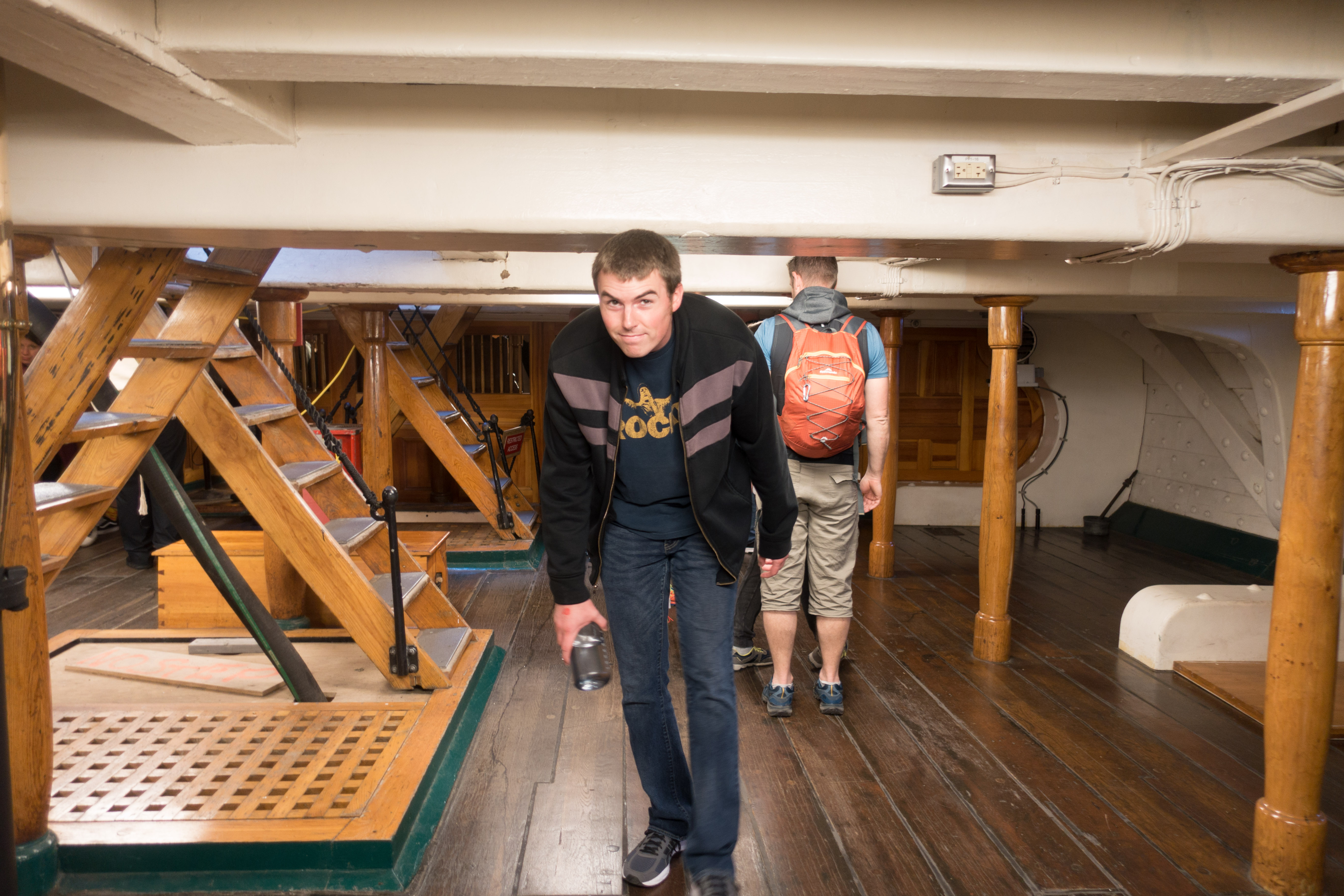
Learn while you walk. Some facts about the USS Constitution:
- The USS Constitution was one of the original six ships of the US Navy.
- In 1905, it was rumored that the USS Constitution was to be used as target practice and sunk to the bottom of the sea. Public outcry saved her from destruction, and in 1907 she began her service as a museum ship open to the public.
- In 1997, the USS Constitution took a celebratory sail in honor of her 200th birthday.
- Each year, the USS Constitution takes a turn around cruise, where she leaves the harbor to, as the name implies, turn around, so that the waves weather on her evenly.
16. Bunker Hill Monument

You’re on the last leg of the trip! Bunker Hill Monument is a 0.4 mile (0.64 kilometer) walk from the USS Constitution. It’s a beautiful, leisurely walk through neighborhoods. Once you’re at the Bunker Hill Monument, you can either stay at the bottom of the hill and check out the Museum and Gift Shop, or you can walk to the top of the hill where the Monument stands. The Monument also functions as an observation deck, free and open to the public. The only catch is, you have to climb up each and every step to get to the top. Remember when, at stop 15, I was saying that last stop was the death of me? I had no idea what lay ahead for me at Bunker Hill.
The monument is 294 steps to the top. I had the bright idea, that after being on our feet for almost ten hours that we should climb to the top of the monument! We did it. It was really, really hard. There is hardly a place to stop the whole way. There is barely any room to let anyone pass. Mostly people passing you will be shimmying past you on their way back down. But it would be almost impossible to let someone behind you pass while taking a break. There just isn’t room. Please know this before committing to climbing to the top. Steep steps. Tight Squeeze. No resting areas. The view (and the cold breeze) at the top is absolutely worth it though! Highly recommend it.
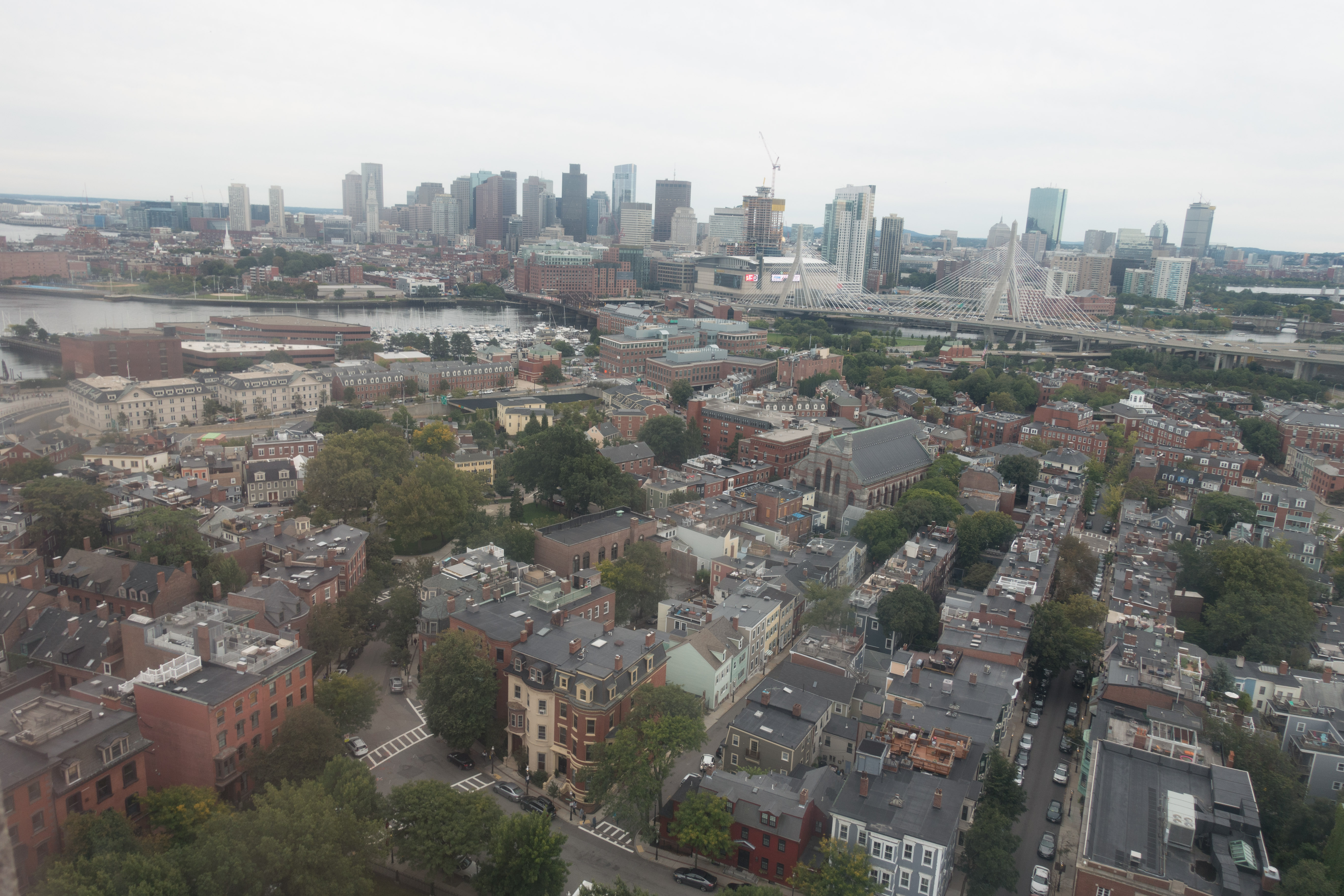
Learn while you walk. Some facts about the Bunker Hill Monument:
- There were many funding delays to get this monument built. In fact, a portion of the originally owned land for this monument had to be sold off in order to complete construction.
- This monument transferred ownership in 1976, now being run by the National Parks Service.
Need a quick and easy printable guide of all this information? There’s a download for that! I’ve created a printer friendly version of this guide, and it’s available for free in my resource library! Get exclusive access below!
Pin Now, Read Later:


yeah bookmaking this wasn’t a bad decision outstanding post! .
Thank you! Glad you found it helpful!
thanks for sharing Kelly 🙂 this year I am planning to visit Boston 🙂 cheers from Lisbon, PedroL
Glad I could help! You’re absolutely going to love Boston!
🙂
The Black Heritage Trail crosses the Freedom Trail between the Massachusetts State House and Park Street Church. The Boston Irish Famine Memorial is also located along the Freedom Trail.
You’re right! We didn’t get a chance to check out the Black Heritage Trail while we were there, but we did see the Boston Irish Famine Memorial and have it labeled on our route as a “bonus stop” because it’s not officially considered one of the 16 stops on the trail.